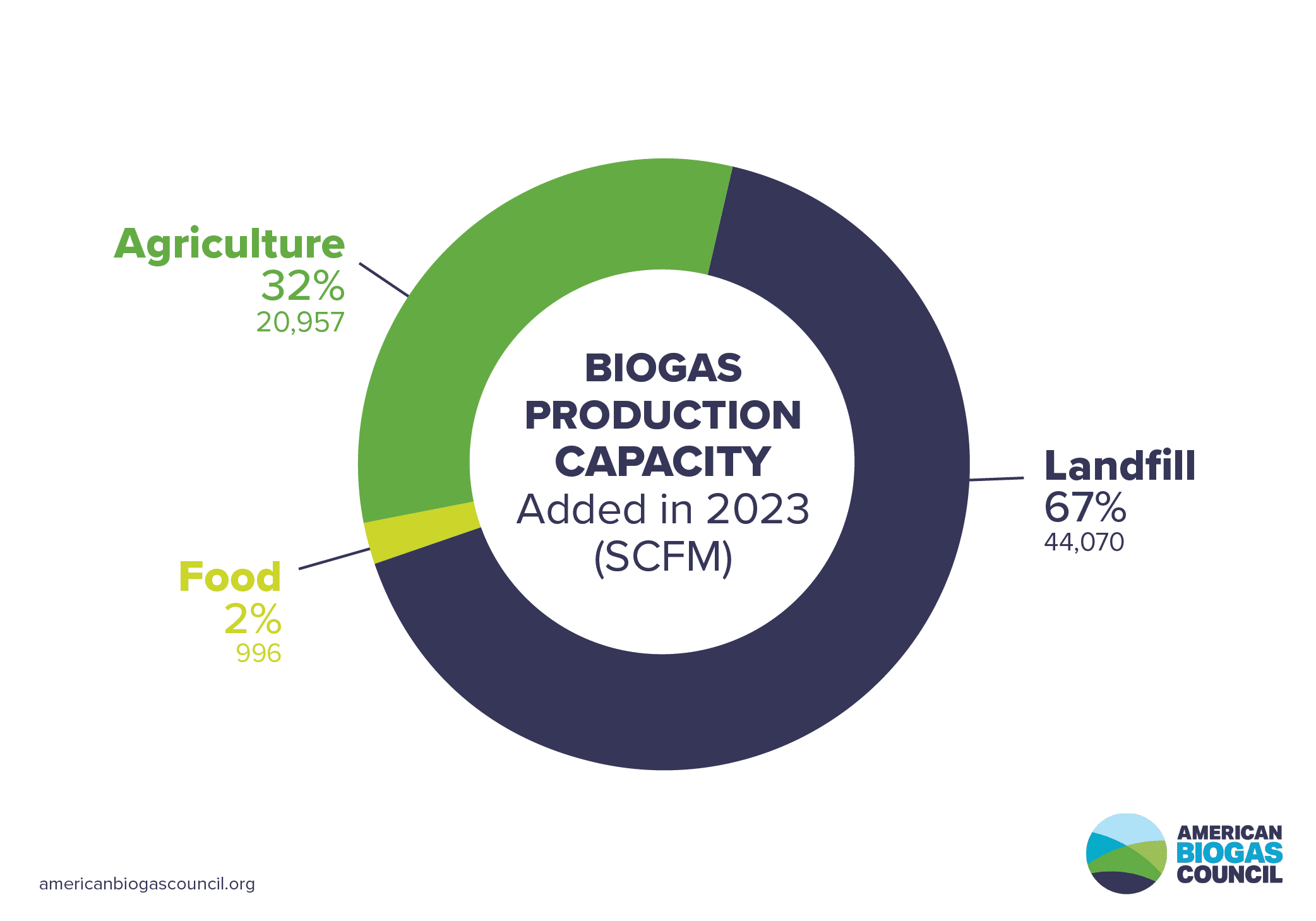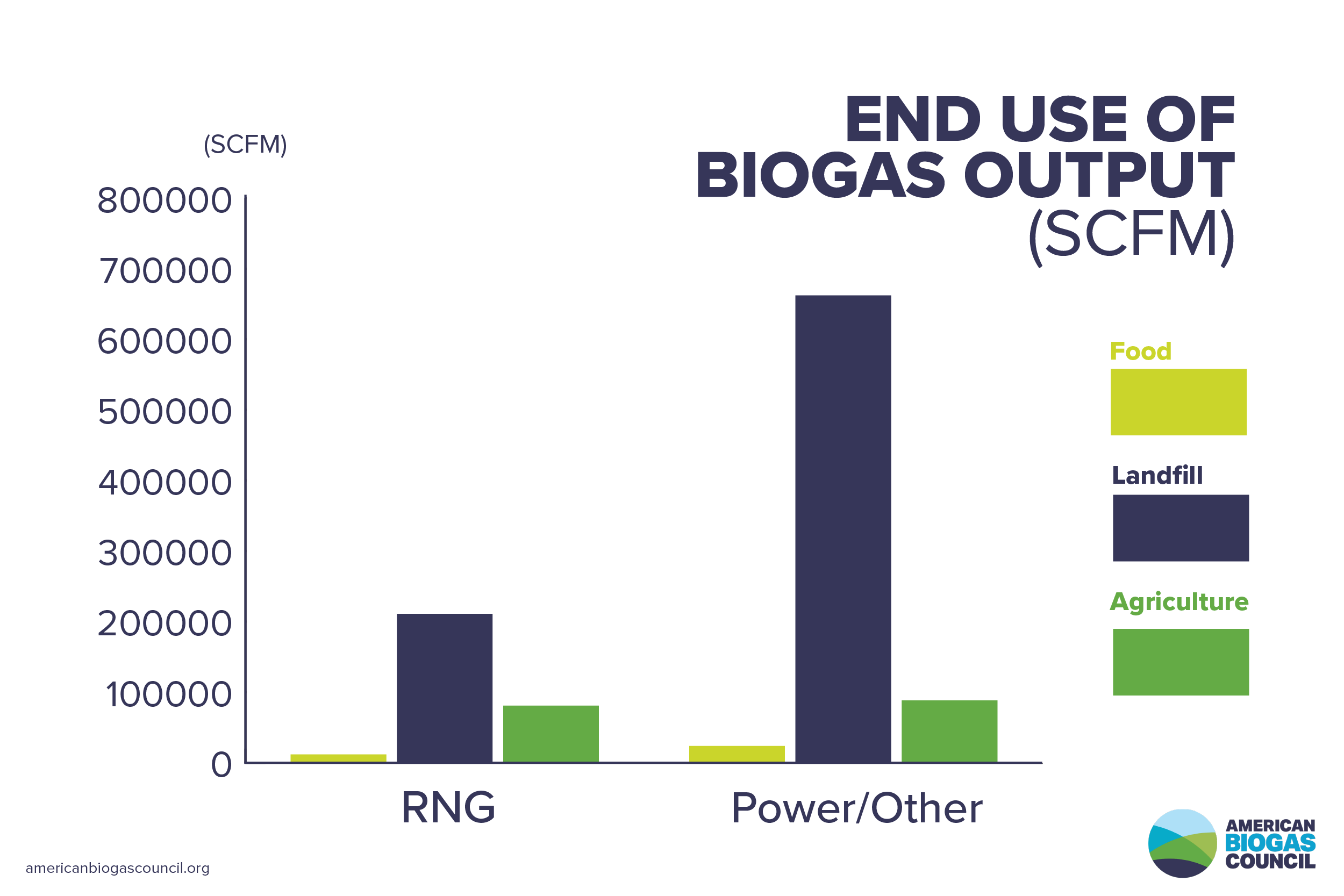
Member Press Release – Third Year of Record Growth for U.S. Biogas Industry; Expected to Continue in 2024
$1.8 billion invested in new projects last year, according to data just released by the American Biogas Council
Washington, D.C. – (February 13, 2024) – Newly-released data from the American Biogas Council (ABC) indicates that 2023 was the third year of record growth across the U.S. biogas industry,[1] with nearly 100 new projects coming online last year, representing $1.8 billion in capital investments. ABC expects this growth to continue into 2024, with more than 100 new projects already projected to go into operation this year.
The growth of the U.S. biogas industry goes beyond increased domestic investments and renewable energy production. Strong industry growth correlated to strong methane emission reductions as well as new construction of recycling infrastructure.
Biogas systems recycle organic waste, capturing methane that would have been produced from that organic material had it not been recycled, and turning it into renewable energy to displace the use of fossil fuels for energy and fertilizer. These systems are a value-packed solution to addressing the urgent U.S. need to manage millions of tons of food, water and animal waste. At the same time, these systems prevent tons of carbon-related emissions from entering the air, keep nutrients from polluting waterways, create healthier soils with natural, non-fossil fuel-based fertilizers, and produce reliable, baseload or dispatchable, renewable energy.
After processing, biogas is most often used as a renewable substitute for natural gas, for electricity, or for heat with a carbon intensity of 50% to 700% less than fossil fuels.
In 2023, 96 new biogas projects[2] became operational in the U.S., pushing the total number of active U.S. biogas projects to 2,251, which represents $39 billion in capital investment. The new projects produce 66,000 standard cubic feet per minute (SCFM) of biogas—an electricity equivalent to 4,000 football fields of solar panels, or powering 600,000 homes, or the fuel equivalent to eliminating 600,000 gasoline cars from the road.

“This is an exciting time of growth for this renewable energy sector that is directly responsible for methane emission reductions,” said Patrick Serfass, executive director of ABC. “As the biogas industry expands, so, too, does our capacity to capture methane emissions that would otherwise be emitted from organic waste. We can simultaneously use that captured methane to displace other emissions from fossil fuels that are used for energy and making fertilizer. It’s a double win that often results in negative carbon emissions. Most other renewables can only get to a carbon intensity of net zero.”
Landfill gas leads both investment dollars and biogas output
Landfill gas (LFG), the natural byproduct of decomposing organic material in landfills—also called biogas—continues to dominate in terms of both total investment and biogas output. Instead of allowing LFG to escape into the air, it can be captured, converted and used to displace fossil fuel emissions. The U.S. currently has 566 LFG projects, including 23 new projects added in 2023. This growth accounts for 57% of 2023 capital investments and a corresponding 67% of new U.S. biogas production capacity.

Significant gains in agriculture, food waste
While the growth of the landfill gas sector was voluminous last year in terms of both dollars and biogas production, 2023 saw only 4-5% growth in that sector. In comparison, agricultural sector experienced 13.4% growth, or nearly three times greater. Seventy new farm-based projects came online in 2023, contributing 21,000 SCFM of additional biogas output and resulting in capital investments exceeding $700 million.
Renewable natural gas (RNG) cluster projects contributed most to this growth and to lowering the cost per project. Cluster projects are generally characterized by multiple farms with at least one anaerobic digester linked together by one common, central gas processing and conditioning facility to turn the biogas into RNG. The use of more lagoon-style biogas systems (a covered, in-ground, lined pit), which are less expensive than the more commonly used engineered tanks, also contributed to lower per-project costs.
Meanwhile, growth also continues in the smaller food waste sector, on par with landfill sector growth. Three new stand-alone food waste biogas projects became operational in 2023, adding an extra capacity of 996 SCFM, bringing the total nationwide to 107. Ten more facilities are scheduled to launch in 2024.
Renewable electricity from biogas remains dominant, but growth is in RNG
While power projects that make renewable electricity from biogas account for 69% of all biogas produced in the U.S., RNG projects represented 91% of all new projects that came online in 2023. This mainly stems from policies such as the federal Renewable Fuel Standard (RFS) and the California Low Carbon Fuel Standard (LCFS), which promote using renewable fuels to replace fossil transportation fuels and to eliminate emissions in natural gas vehicles. The inability for biogas projects to participate in the RFS when fueling electric vehicles continues to suppress growth in new power projects.

While impressive growth in the U.S. biogas industry continues, only roughly 20% of possible projects across the country have been built. ABC counts at least 15,000 new systems that could be built—compared to 2,251 operational today—based on the millions of tons of organic material in the U.S. produced annually by humans and animals. As the biogas industry continues to expand, significant economic, environmental and energy advantages are unlocked.
The collective impact encompasses several benefits, including carbon reduction, improved water quality, soil health enhancements and reliable, renewable energy. Embracing biogas systems signifies a proactive step toward a sustainable future, where environmental stewardship and resource efficiency converge for the betterment of society and the planet.
[1] Excludes the wastewater treatment sector which represents approximately 1,000 biogas-producing facilities.
[2] A farm with at least one digester is counted as a single project.
-ENDS-
About the American Biogas Council
The American Biogas Council is the voice of the US biogas industry dedicated to maximizing carbon reduction and economic growth using biogas systems. We represent more than 400 companies in all parts of the biogas supply chain who are leading the way to a better future by maximizing all the positive environmental and economic impacts biogas systems offer when they recycle organic material into renewable energy and soil products. Learn more online at AmericanBiogasCouncil.org, X @ambiogascouncil, and LinkedIn.
Media Contact: Hayley Maynard, 614.701.8205, hayley@americanbiogascouncil.org.

